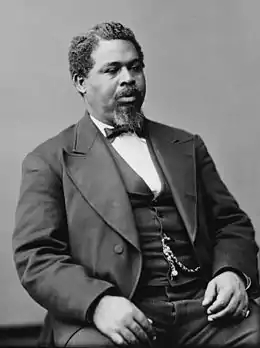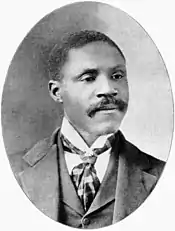| South Carolina's 7th congressional district | |||
|---|---|---|---|
Interactive map of district boundaries since January 3, 2023 | |||
| Representative |
| ||
| Population (2022) | 762,499[1] | ||
| Median household income | $53,313[1] | ||
| Ethnicity |
| ||
| Cook PVI | R+11[2] | ||
| Created | 2013 | ||
South Carolina's 7th congressional district is a congressional district for the United States House of Representatives in South Carolina, established in 2011 following apportionment of another seat to the state in the redistricting cycle following the 2010 census. It is located in the Pee Dee region, and includes all of Chesterfield, Darlington, Dillon, Georgetown, Horry, Marion, and Marlboro Counties and most of Florence County. The district is represented by Republican Russell Fry who was elected in 2022 and took office on January 3, 2023.
History
The 7th congressional district of South Carolina existed in the 19th century, but was eliminated in 1853 as a result of the 1850 census. After the 1880 census, Congress apportioned the state another seat, and the state legislature re-established the district.
By that time, the Reconstruction era had ended and the state legislature was controlled by Democrats, who wrested control by a mixture of violence and fraud. They defined the boundaries of the 7th district, which was called the "shoestring district" because of its long, narrow shape that included many black precincts. In 1892 and 1894 the majority-black voters of the district elected George W. Murray to Congress; he was the only African American to serve in Congress in those sessions and, following disfranchisement and demographic changes, the last elected from the state until Jim Clyburn in 1992.
In 1895, the Democrat-dominated state legislature passed a new constitution, disfranchising black voters by changes to voter registration and electoral rules that were applied against them in a discriminatory way. For decades after 1896, only white Democrats were elected to Congress from the state. (Such disfranchisement occurred among all the states of the former Confederacy, and their use of poll taxes, literacy tests, grandfather clauses, and white primaries survived several US Supreme Court challenges.)
During the first half of the 20th century, 6.5 million blacks in total left South Carolina and other southern states in the Great Migration to the North, Midwest and West. Following cumulative declines in state population, after the 1930 census, South Carolina lost a seat and the 7th district was eliminated in redistricting. It was last represented by Democrat Hampton P. Fulmer, who was redistricted into the 2nd district.
South Carolina had only six districts for the next 80 years. African Americans were effectively barred from voting until after passage of the Voting Rights Act of 1965. Increases in population led to the state's receiving another congressional seat in the redistricting cycle following the 2010 census.
The 7th district is located in the rapidly developing area of northeastern South Carolina, including the Myrtle Beach metropolitan area (the Grand Strand) and the Pee Dee region.[3][4] It is a white-majority district and its voters elected Republican Tom Rice as US Representative from the district in 2012; he took office in January 2013, when the 113th Congress convened. Due almost entirely to the presence of heavily Republican Horry County, which has as many people as the rest of the district combined, it tilts Republican.
The district boundaries are roughly similar to the configuration of the 6th congressional district before it was reconfigured after the 1990 census as a black-majority district.
Counties
Counties in the 2023–2033 congressional district map:
Election results from presidential races
| Year | Office | Result |
|---|---|---|
| 2012 | President | Romney 54.5–44.4% |
| 2016 | President | Trump 58–39.1% |
| 2020 | President | Trump 58–40.2% |
List of members representing the district
Past election results
2012
| Party | Candidate | Votes | % | ||
|---|---|---|---|---|---|
| Republican | Tom Rice | 153,068 | 55.5 | ||
| Democratic | Gloria Tinubu | 122,389 | 44.4 | ||
| Write-in | 281 | 0.1 | |||
| Total votes | 275,738 | 100.0 | |||
| Republican win (new seat) | |||||
2014
| Party | Candidate | Votes | % | |
|---|---|---|---|---|
| Republican | Tom Rice (Incumbent) | 102,833 | 59.9 | |
| Democratic | Gloria Bromell-Tinubu | 68,576 | 40.0 | |
| Write-in | 115 | 0.1 | ||
| Total votes | 171,524 | 100.0 | ||
| Republican hold | ||||
2016
| Party | Candidate | Votes | % | |
|---|---|---|---|---|
| Republican | Tom Rice (incumbent) | 176,468 | 61.0 | |
| Democratic | Mal Hyman | 112,744 | 38.9 | |
| Write-in | 251 | 0.1 | ||
| Total votes | 289,463 | 100.0 | ||
| Republican hold | ||||
2018
| Party | Candidate | Votes | % | |
|---|---|---|---|---|
| Republican | Tom Rice (incumbent) | 142,681 | 59.6 | |
| Democratic | Robert Williams | 96,564 | 40.3 | |
| Write-in | 309 | 0.1 | ||
| Total votes | 239,554 | 100.0 | ||
| Republican hold | ||||
2020
| Party | Candidate | Votes | % | |
|---|---|---|---|---|
| Republican | Tom Rice (incumbent) | 224,993 | 61.8 | |
| Democratic | Melissa Ward Watson | 138,863 | 38.1 | |
| Write-in | 235 | 0.1 | ||
| Total votes | 364,091 | 100.0 | ||
| Republican hold | ||||
2022
| Party | Candidate | Votes | % | |
|---|---|---|---|---|
| Republican | Russell Fry | 164,440 | 64.7 | |
| Democratic | Daryl W. Scott | 89,030 | 35.0 | |
| Write-in | 395 | 0.1 | ||
| Total votes | 253,865 | 100.0 | ||
| Republican hold | ||||
See also
References
- 1 2 "My Congressional District". census.gov. U.S. Census Bureau Center for New Media and Promotion (CNMP).
- ↑ "2022 Cook PVI: District Map and List". Cook Political Report. Retrieved January 10, 2023.
- ↑ "Census 2010 shows Red states gaining congressional districts". Washington Post. Retrieved December 21, 2010.
- ↑ "Archived copy" (PDF). Archived from the original (PDF) on April 13, 2014. Retrieved May 4, 2014.
{{cite web}}: CS1 maint: archived copy as title (link) - ↑ "Election Statistics - US House of Representatives: History, Art & Archives". Karen Haas, Clerk of the United States House of Representatives. Retrieved February 23, 2013.
- ↑ The votes for the Democratic candidate includes votes cast for the candidate who also ran under the Working Families Party ticket
- ↑ "South Carolina Election Commission Official Results". West Virginia Secretary of State. November 4, 2014. Retrieved January 8, 2015.
- ↑ "2016 Statewide General Election official results". South Carolina State Election Commission. Retrieved December 5, 2016.
- ↑ Johnson, Cheryl L. (February 28, 2019). "Statistics of the Congressional Election of November 6, 2018". Clerk of the U.S. House of Representatives. Retrieved April 27, 2019.
- ↑ "2020 Statewide General Election Night Reporting - Results". South Carolina Election Commission. November 10, 2020. Retrieved November 11, 2020.
- ↑ "2022 Statewide General Election". www.enr-scvotes.org. November 11, 2022. Retrieved January 2, 2023.
- Martis, Kenneth C. (1989). The Historical Atlas of Political Parties in the United States Congress. New York: Macmillan Publishing Company.
- Martis, Kenneth C. (1982). The Historical Atlas of United States Congressional Districts. New York: Macmillan Publishing Company.
- Congressional Biographical Directory of the United States 1774–present
.svg.png.webp)
.png.webp)



.jpg.webp)



.jpg.webp)


.jpg.webp)
.tif.png.webp)
